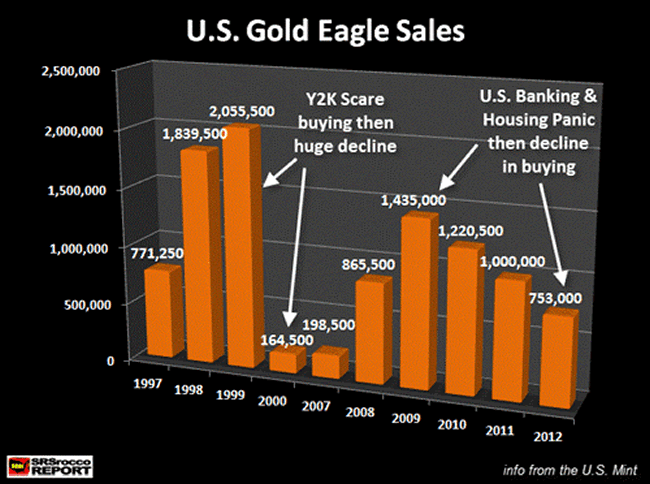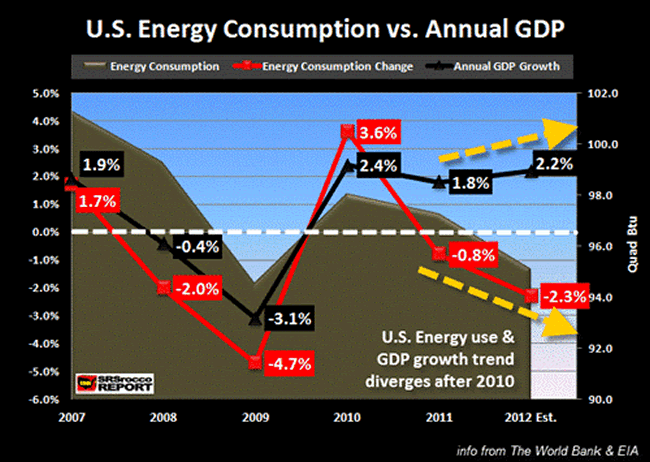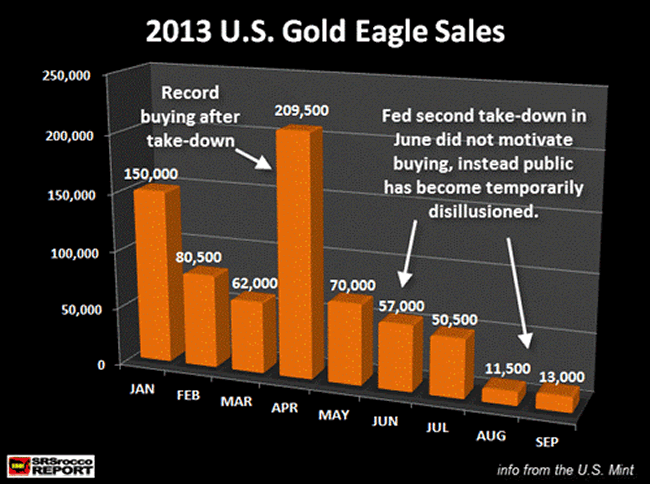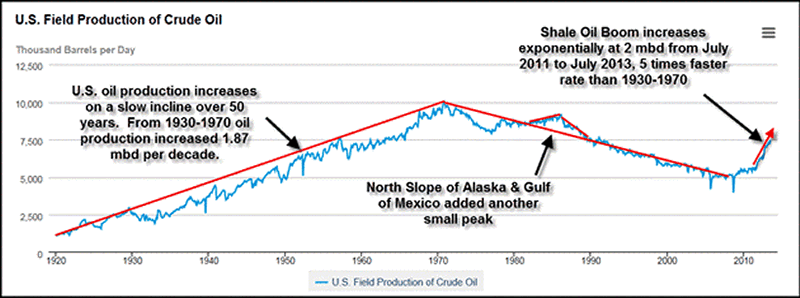The Calm Before the Gold and Silver Precious Metals Storm
Commodities / Gold and Silver 2013 Oct 10, 2013 - 06:42 PM GMTBy: Steve_St_Angelo
 The financial hurricane hit the world in 2008 destroying huge swaths of assets, real estate valuations, numerous banks and financial institutions. As the storm cleared, the Fed and central banks stepped in by flooding the world with money to supposedly assist in dealing with the damage while providing special programs to rid the banks of debris and garbage clogging up their businesses.
The financial hurricane hit the world in 2008 destroying huge swaths of assets, real estate valuations, numerous banks and financial institutions. As the storm cleared, the Fed and central banks stepped in by flooding the world with money to supposedly assist in dealing with the damage while providing special programs to rid the banks of debris and garbage clogging up their businesses.
After trillions of dollars of so-called monetary assistance, the financial damage appears to be repaired giving the public a false sense of security that the storm has finally passed. Unfortunately, the world has only dealt with the first part of the storm and is now sitting in the eye of the financial cyclone.
Even though we now have the additional drama from the U.S. Government shutdown, up until recently, the economy has been plugging right along. However, this was a much different story back in 2008 when the public and investors thought the world was coming to an end.
This can clearly be seen by the huge increased buying of Gold Eagles during 2008 & 2009:

Notice in 2007, total Gold Eagle sales were only 198,500 oz, but after the banking and housing collapse in 2008, buying more than quadrupled to 865,500 oz. Furthermore, when the broader stock markets continued to tank in 2009, Gold Eagle sales reached 1.4 million oz.
As the Fed and central banks continued to print, prop-up and backstop their respective fiat currencies and broader stock markets, the demand for gold continued to decline. In 2011, Gold Eagle sales slipped to 1 million oz. and down to only 753,000 oz. in 2012.
This is typical market psychology. A similar but more volatile trend took place during the millennium. Americans worried about Y2K purchased record amounts of Gold Eagles in 1998 (1,839,500 oz) and in 1999 (2,055,500 oz), but as the 2000 came and went without any major disruptions, demand nearly dried up to a pathetic 164,500 oz.
After the world escaped the collapse of the financial system with the help of the Fed & Central Bank Global QE, economic conditions in the U.S. started to wane in 2012. This can be seen by the decline of energy consumption in the country:

Here we can see that as energy consumption fell, so did the GDP. However, there was a disconnect that started in 2011 and increased significantly in 2012 as energy consumption declined, the GDP increased -- nothing like manipulated economic data to give the illusion of growth
This is part of the reason why the Fed announced QE3 in Sept of 2012... it had to add additional stimulus to keep the economy from imploding further. Unfortunately for the Fed, this huge increase in monetary printing would have had a direct impact on the precious metals pushing their prices to new record highs.
To keep the precious metals from exploding higher, price action was capped at the end of 2012 and then after several huge raids in 2013, market sentiment in gold and silver was severely eroded as demand in the West dried up.
In the chart below, we can see how orchestrated manipulation of the precious metals can impact market psychology.

During the first take-down in the price of gold, investors bought record Gold Eagles in April. However, as gold was hit again in June, buying slowed considerably and has been falling ever since.
The one thing that fiat monetary authorities understand, is market psychology. To destroy market sentiment in gold, a broad-based approach had to be implemented. With the help of its member banks and financial networks, investors now question if gold really is a safe haven anymore.
Of course this does not apply to the "1% Educated" precious metal investors as they realize you can't manipulate fundamentals forever, but it does impact the psychology of the 99% -- and this is the group that would ultimately push gold to highs never seen before.
This next chart shows just how desperate the Fed has become in taming the Wild Monetary Golden Beast:

The price of gold presently ($1,310) is actually lower than it was before the Fed started QE2 back at the end of 2010. Now, some analysts are saying that the reason why gold is under-performing is due to the fact that inflation is not as much of a threat as previously forecasted.
That is an interesting notion if we consider that the price of a barrel of West Texas Crude Oil increased from $85 in Nov. 2012 to a high of $110 recently (quite an inflationary trend) as gold declined from $1,750 to below $1,300 during the same time period. I find it simply ironic that the price of oil in the United States has risen nearly 30% in the past year as domestic production has increased to levels not seen for over 20 years.
The reason for the big increase in domestic oil production has to do with the so-called success of shale oil in the states. The hype by the oil industry is that shale oil will provide cheap and an abundant supply in the future. The United States is banking on shale oil to make the country.... energy independent.
Furthermore, I have stated that an increasing energy supply is vital in keeping a fiat monetary system alive. However, it doesn't look as if shale oil will be the savior for the country or the Dollar for that matter. U.S. oil production increased steadily since 1920. From 1930 to 1970, oil production increased an average of 1.87 million barrels a day (mbd) each decade.

However, shale oil has pushed domestic oil production up 2 mbd from July 2011 to July 2013, which is five times faster than its historic rate. Shale oil production is increasing at an exponential rate. The problem with any trends that increase exponentially, is that they decline is the same fashion. With all BOOMS... comes the inevitable BUST.
Shale oil should be used to assist the United States into transitioning to a more smaller, local and sustaining economy. Unfortunately, it is being utilized today just to keep the illusion of perpetual growth forever.
Many analysts including those from the Austrian School of Economics believe the U S. has trillions of barrels of oil resources, so there is no need to worry about energy shortages in the future. A large part of these supposed oil resources are found in geology called OIL SHALE. This should not be confused with shale oil (tight oil) that is being extracted from the Bakken and Eagle Ford in the U.S.
Oil shale is not even oil, but rather a form of kerogen shale that needs a great deal of energy to heat, extract and then refine. Several large oil companies have been working on making this resource commercial in the states. But, bad news just came out recently when Shell announced they were going to abandon their oil shale project:
Shell Abandons 800 Billion Barrel Deposit, Beaten By the Regions Geology:
The belief that technology can always overcome natural limits just took a big hit this week when Royal Dutch Shell PLC decided to shut down its pilot oil shale project in western Colorado after 31 years of experimentation. The ostensible reason is that the company has opportunities elsewhere. Shell says it wants to shift resources away from the intransigent rock and move it to profitable opportunities.
...Proponents of oil shale claimed in 1981 that it would be economical to process if oil were to reach $38 per barrel and stay there. The threshold price kept escalating along with the price of oil all the way up to $80 in a 2008 study by the U.S. Bureau of Land Management.
And, yet here we are. Brent Crude, the de facto world benchmark, hovers around $108 dollars. The average daily price for the past three years has remained above $100. In the face of these consistent record high prices, Shell is abandoning oil shale development. And, Shell isn't the only one. Another international major, Chevron Corp., pulled out of its project last year.
Large oil companies are getting out of the oil shale business at time when the world is experiencing the highest average oil prices. As the article stated, not only is Shell abandoning its oil shale project, Chevron pulled out if its project last year.
The reason why I include ENERGY-OIL in a precious metal article is that it is directly related to the future valuations of gold & silver even though investors don't see it that way. They rather focus on short-term information that reinforces their belief in the metals than longer term fundamentals that will guarantee much higher rewards.
The future energy situation is more important to the precious metal investors than are Comex inventory levels or sensational articles based on superficial information. The world is now passing out of the EYE OF THE STORM and back into the FINANCIAL TYPHOON.
Energy is the blood that allows the fiat monetary system to survive. Shale oil has been hyped by the industry and broadcasted by the media because it is the only thing left to keep the illusion of growth. Without energy growth the Dollar would surely die.
Even though the Fed and Central Banks have been able to manipulate, control and divert interest away from the precious metals presently, the rear of the PRECIOUS METAL HURRICANE is still approaching.
At the SRSrocco Report, we will explore how energy will impact the mining industry in the future. Falling ore grades and decreasing yields are only part of the problem. As net oil exports continue to decline, energy prices will rise putting more pressure on the mining industry. Thus, rising energy costs will guarantee rising prices of gold and silver.
© 2013 Copyright Steve St .Angelo - All Rights Reserved Disclaimer: The above is a matter of opinion provided for general information purposes only and is not intended as investment advice. Information and analysis above are derived from sources and utilising methods believed to be reliable, but we cannot accept responsibility for any losses you may incur as a result of this analysis. Individuals should consult with their personal financial advisors.
© 2005-2022 http://www.MarketOracle.co.uk - The Market Oracle is a FREE Daily Financial Markets Analysis & Forecasting online publication.



